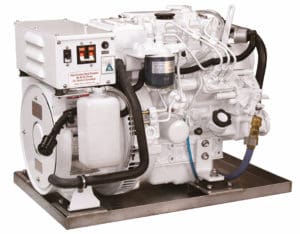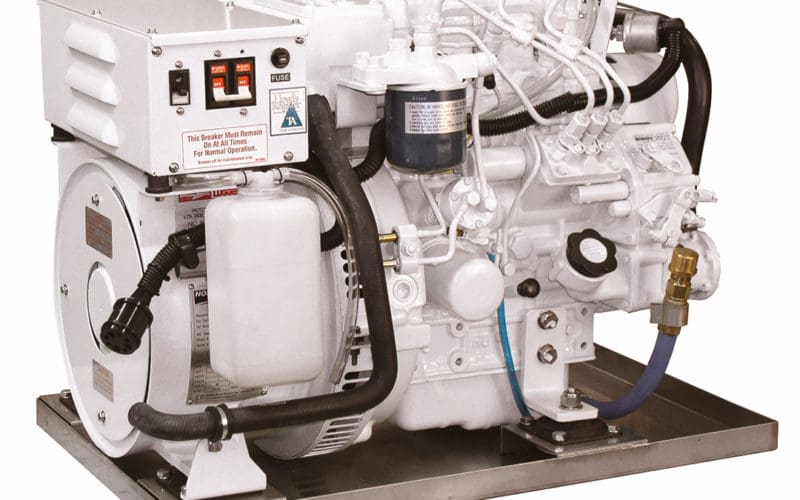
A key electrical system component for many voyaging vessels is a diesel generator, commonly known as a genset. While gensets may seem, at first glance, just like diesel propulsion engines, they actually have unique operating parameters that differentiate them from an engine designed to turn a prop. Have recent trends in diesel propulsion engines — high RPM operation, common rail fuel systems and integrated circuit electronic control — found their way into the more specialized needs of gensets?
A propulsion engine, of course, is called on to provide power across a range of throttle settings — because there are times, like in harbor, you want to power ahead slowly, while other situations require full power, cruising speed, etc.
A genset is a different beast in that its main task is not to provide motive power but to turn a generator for making electricity. A generator doesn’t require a variety of RPM settings. One steady RPM is fine. And knowing what RPM is best for the generator allows the genset manufacturer to optimize the diesel for most efficient operation at that RPM. So, while a propulsion engine has to be something of a generalist and do a lot of RPM settings well, a genset is a specialist designed to happily operate at one RPM setting.
In previous times, diesel engines, no matter their function, tended to operate at low RPM and used individually-pressurized injectors — one of the things that gave a diesel its characteristic “clatter.” In the past few years, however, many manufacturers have designed their diesel propulsion engines to operate at a higher RPM. Higher RPM operation can push an engine’s output to the higher end of the torque curve and thus produce more power.
Another trend in propulsion diesels is the move to “common rail” fuel systems. Older diesels used a fuel pump to send fuel to individual injectors which then injected fuel into each cylinder. A common rail diesel pressurizes a tube (the common rail) of fuel and then each injector can make use of this pressurized fuel as directed by the engine controller. Fuel can be injected several times into each cylinder during every power stroke, allowing the fuel burn to be more tightly controlled and efficient.
With the more demanding millisecond-level engine control needs of common rail-based engines, many manufacturers have gone to computer chip-equipped circuit boards to handle fuel injection and other engine control tasks. A possible downside to electronic control is an electrical surge caused by, for example, a nearby lightning strike. The broadband blast of energy from lighting, called electromagnetic pulse (EMP), can damage computer chip circuitry and leave an engine without a controller, rendering it inoperable. While EMP damage from lightning is a rare occurrence, it is a possibility, especially in areas with frequent thunderstorms.
So, what effect have propulsion engine trends had on the diesel engines used for gensets? I asked two genset providers, Northern Lights and Cummins Onan about these trends and the answers I received highlighted the design approaches of these two genset providers.
Focusing in its smaller sized gensets, like the M673L3G 6 kilowatt model, Northern Lights factory trainer Bob Senter replied this way: “Synchronous generators, currently the most common design, run at a constant RPM in order to maintain 60 Hz or 50 Hz frequency. Higher RPM is less fuel efficient, noisier and decreases engine life. Common rail fuel systems are very efficient at all RPM’s in almost all engine sizes.” The M673L3G fits in with this philosophy, as it operates at 1,800 RPM’s.
Michael LeNeave, genset product manager at Cummins Onan, when asked about the Cummins Onan QD 4/5 model, put his company’s approach to gensets this way: “While we have had higher RPM models in the low kW range for years, ranging back to the 1990’s, our current product lineup high RPM models are driven more by optimal power being higher in the engine speed of the smaller engines that are used. The model you are referring to is using the engine to spin the alternator via a drive belt; we selected the belt ratio for the desired engine and alternator speeds. On larger generator sets, alternators are coupled directly to the engine’s crankshaft, where you will see engine speeds of 1,500rpm (50Hz output) or 1,800rpm (60Hz output).”
When it comes to electronic engine control, the two companies each have their own philosophy. Senter, again, on why Northern Lights relies on relays and not computer chips. “Relays are far less sensitive to external electro magnetic and radio frequency pulses (EMP) than microprocessors. They are also considerably more heat resistant, easier to diagnose in the field, readily available in most parts of the world and cost only a fraction the price of complex microprocessors.”
LaNeave, meanwhile, stressed the advantages that electronic control gives you in distributing data from the genset. “All of the Cummins Onan marine generators have a genset controller to control operating parameters. The data link translates the genset control language into J-1939, which is a common industry language for displays and controls used in the marine vessels. This way, various genset outputs, such as the frequency, can be displayed on remote panels in the cabin.”
So, it seems that if your voyaging generally takes you to remote places where ruggedness and simplicity are the paramount virtues, the Northern Lights approach might be your best bet. While a boat that cruises nearer to well-equipped boat yards could be very happy with the Cummins Onan computer-controlled setup. As with every piece of electrical gear, there are varying design paths for solving the same problem. Which means, as it should, that the choice is up to the individual boat owner to decide what mix of performance, reliability and repairability he or she values most on their boat. n

